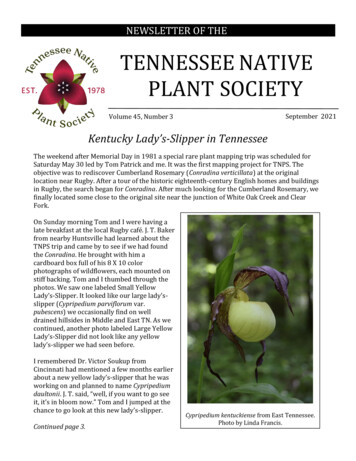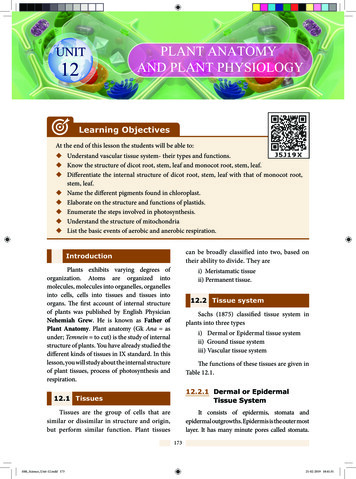
Transcription
SempervirensSeptember 2020The Quarterly of the Virginia Native Plant SocietyChris Ludwig’s virtual tour of the state’s Natural Area Preserves will include visits toSavage Neck Dunes, above, and The Channels. Photos by Gary Fleming.Annual Meeting goes virtual on Sept. 25This year we will gather virtually for ourannual meeting so you can participatefrom the comfort of your own home.We will begin with a half hour businessmeeting where you will meet and vote onmembers for the board of directors, adoptthe annual budget, and hear about thestate of the organization. We will send youan official notice by email to register andfollow up with reminders.The VNPS is pleased to have ChrisLudwig as our keynote speaker. For 32years, Chris explored the flora of Virginia.During his explorations, he documentedmore than 1,000 rare plant populationsand discovered or co-discovered 20 newplant species previously undocumentedfrom the Commonwealth, two of whichare new to science. Much of this worktook place when Chris worked for theVirginia Natural Heritage Programwithin the Department of Conservationand Recreation. There he served asStaff Botanist from 1988 to 1996 andChief Biologist from 1997 until his2019 retirement.In 2000, Chris joined Marion Lobsteinand Joslin Gallatin to form the Foundationof the Flora of Virginia Project andhe worked over the next 12 years toproduce the Flora of Virginia, a 1,554page illustrated manual that describesVirginia’s vascular plants with details ontheir taxonomy, morphology, ecology,biological status, and identification. Chrisco-authored this work with Alan Weakleyand Johnny Townsend. The volume wasconverted into the Flora of Virginia appthat is available on Android and IOS. Theapp enhances the original work with agraphic key that enables identificationby less experienced naturalists. A majorupdate is scheduled in December of 2020.As most folks interested in theconservation of our native plants andanimals know, Virginia has a vibrantsystem of Natural Area Preservesscattered throughout the Commonwealthfrom the far reaches of western Virginiaall the way to the Eastern Shore. Thebeauty of these Preserves is that theywere protected for their biodiversity bythe Virginia Natural Heritage Programand they make up some of the mostimportant protected conservation landsin Virginia.Further, many of these sites are opento the public and some of our best nativeplant displays can be found within them.Chris’s presentation will provide a virtualtour of the Natural Area Preserve system.It is set up to take us to the preservesduring prime viewing time. Along withthe botanical highlights, we will learnabout other special features such as theoutstanding forest of the Crows NestNatural Area Preserve, the rolling sanddunes of Savage Neck Dunes Natural AreaPreserve, the labyrinthian rock formationsof The Channels Natural Area Preserve,and the all-but-lost longleaf pine forestbeing brought back in the Natural AreaPreserves of southeastern Virginia.Look for registration information inyour email box. With no travel required,we hope to have record participation forthis year’s annual meeting. v
Sempervirens, September 20202Native Plant excitement still running highFrom the President,Nancy VehrsGreetings, everyone! Covidcontinues to be a menacingpresence in our lives, but I hopethat you all are well and canfind solace in nature. This year Iattained the magical age of 62, entitling me to my very own Americathe Beautiful Lifetime Senior Pass.I had hoped to buy one for myselfon my actual birthday, but I had towait a few months as national parkfacilities closed for the pandemic.Shenandoah National Park reopened, and I bought myself thecoveted “geezer pass,” as I affectionately call it. For just 80 thispass “provides entrance or accessto pass owner and accompanyingpassengers in a single, private,non-commercial vehicle at Federaloperated recreation sites acrossthe country.” I’ve been to SNP a fewtimes this summer and its refreshingly cool mountain air and vividwildflowers and butterflies restorethe tired soul. We are so fortunateto have such a mountain oasis inour Commonwealth. I hope to continue to take advantage of my passin the months and years to come.As you can imagine, the VNPSboard decided that this year’s annual meeting will be held virtuallythrough Zoom. We will conductour usual brief business meetingwhere we hear a few reports andtake a vote to consider a changeto our bylaws to formalize virtualmeetings, elect members to ourboard of directors, and accept thebudget. This will be followed bya presentation by Chris Ludwig, aco-author of the Flora of Virginiaand formerly on the staff of Virginia’s Natural Heritage Program.He will take us virtually aroundour Commonwealth to visit someof our most precious ecologicaltreasures. While we may not havea chance to renew our friendshipsthrough a virtual meeting, we canshare a common presentation thathas a chance to be our highestattended meeting ever. Virtualmeetings allow everyone withinternet access the opportunity toparticipate from afar.We will present some newmembers for the board of directors. Emily Ford is completing herMany people are finding added solace this year during the pandemic by visiting outdoor spaces across the Commonwealth. Oneof those places is Shenandoah National Park, seen here offering natural views both close-up, like this Tiger Swallowtail on WildBergamot (Monarda fistulosa), and farther away as seen by the mountains in the distance. Photo by Nancy Vehrs.
Sempervirens, September 2020Joey Thompsonterm as Education Chair on theboard, and Joey Thompson wasnominated to succeed her. Thankyou, Emily, for your service toVNPS! Joey is a Richmond nativeand a life-long nature lover. Hebegan studying botany and floristics at the College of William& Mary, and he went on to studybarrier island shrub ecology forhis master’s at Virginia Commonwealth University. Now, Joey worksas an environmental scientist foran engineering firm called VHB.At VHB, Joey conducts full floristicinventories and surveys for rare,threatened, and endangered plantspecies. He also surveys for avariety of other natural resourcessuch as wetland and streams. Inhis three years at VHB, Joey hasconducted floristic inventories in10 states from Vermont to Florida.Joey also has a love for teachingothers about plants. He teachesan introduction to botany courseat Lewis Ginter Botanical Gardenand leads plant walks for a varietyof audiences including the VNPS,VCU classes, the Richmond Garden3Club, local high schools, andthe Richmond Invasive PlantTask Force. Joey has an aweand fascination for wild plantsthat he wants to share with everyone. When he is not spending his spare time with friendsand family, he is out searchingfor new sites to botanize andcollecting specimens to identify at home.We are pleased to announcethat Kathleen O’Shea has volunteered for the vacant Membership Chair. Kathleen beganher career as an archaeologist,which required an understanding of indigenous and anthropogenic plants in the interpretationof landscapes. Her fascination initially focused on edible and medicinalplants, but eventually she discoveredthe value of flora she could not eat.She was immersed in the world ofnative plants during her five-plusyears working at Huntley MeadowsPark, a Fairfax County nature preserve in Alexandria. Her professionalexperience includes managing parkoperations, coordinating volunteers,marketing, and public outreach. Ofcourse, she is also very skilled inthe use of a wide variety of diggingtools. Kathleen was raised in Burke inNorthern Virginia and is an alumnaof James Madison University. Sheand her husband live with their twoyoung sons in the Richmond area.She believes in the mission of theVNPS and will focus her efforts onassisting local chapters engage andretain members through outreachand partnerships.The board of directors appointed Ashley Moulton as PublicityChair at its quarterly meeting inJune. This was a temporary appointment until the next electionso she will be on the ballot forthe remainder of the term. SheKathleen O’Sheainitiated our Instagram page andwas profiled in the spring issue ofSempervirens.I hope that many of you willtune in to our annual meeting onSeptember 25. Remember, theorganization is only as strong asits members. vSempervirens (ISSN 1085-9632)is the quar ter ly newsletter ofthe Virginia Native Plant Society,Blandy Experimental Farm, 400Blandy Farm Lane, Unit 2, Boyce,Va. 22620, 540-837-1600, info@vnps.org. Nancy Vehrs, President;Nancy Sorrells, Editor; KarenYork, Office Manager. Originalmaterial in Sempervirens may bereprinted if credit is given to theVirginia Native Plant Society, toSempervirens, and to the authorof the material, if named. Readersare invited to send letters, newsitems, and queries for consideration. E-mail items to NancySorrells at lotswife@comcast.net.Next submission deadline:Oct. 31, 2020
Sempervirens, September 20204Quarry GardensNew Society Registry Site in Nelson CountyArticle and photos by Charles Smith, Co-Registry ChairThe Virginia Native PlantSociety is happy to announcethe designation of the QuarryGardens at Schuyler as our newestRegistry Site. The VNPS RegistryProgram is intended to work withproperty owners to protect andpromote the preservation of andeducation about Virginia’s floristicheritage. The Quarry Gardensat Schuyler is a unique place,seeking to preserve rare plantsand communities and the animalspecies they support, highlightunique geology and humanhistory, restore disturbed lands,introduce native plants speciesendemic to within 15 miles of thesite, and welcome the public into appreciate and learn from itsrich assemblage of biota and thelandscape.The Quarry Gardens atSchuyler, located in northernNelson County southwest ofCharlottesville, were createdthrough the vision and passionof owners Bernice and ArmandThe visitor center at the Quarry Gardens at Schuyler.The rock walls of the former soapstone quarry are reflected in the water that fills the former miningpit at the Quarry Gardens at Schuyler.Thieblot. Bernice and Armandpurchased 600 acres of land thatincludes former soapstone quarriesin 1991. They were inspired tocreate a conservation site andpublic garden after visiting theButchart Gardens in Vancouver,British Columbia, in 2013, whichhas a portion of the botanic gardenswithin an old quarry. Bernice andArmand envisioned a site focusedon native plant species.The Thieblots’ first step was tounderstand better what was on theproperty. They enlisted the servicesof Devin Floyd of the Center forUrban Habitats in Charlottesvilleto conduct surveys and developdesigns for the gardens as wellas restoration and managementplans for the remaining naturalcommunities on site.In 2015, the Thieblots placed aconservation easement on a 400acre buffer around the gardens. A40-acre area centered on the oldquarry pits became the focal pointfor the gardens and preservednatural plant communities.The Quarry Gardens opened inthe spring of 2017. The gardens are
Sempervirens, September 2020designed on ecosystem modelingprinciples, taking advantage ofthe unique characteristics of 14ecozones and 7 conservation areas.Two miles of trails take visitorsthrough more than 30 designedgalleries of local native plantcommunities, including manyplants propagated from the site.The visitor center offers exhibitson native plants, local ecosystems,and the history of the soapstoneindustry in Schuyler. It also has aclassroom where visitors can watcha short film orienting them to thesite’s resources. A picnic pavilionwas completed near the visitorcenter earlier this year.Schuyler is the number onesource of soapstone, or talc-richsteatite in the world. Soapstonequarrying began there in the1890s. Quarrying operations onthe Thieblots’ property took placebetween the 1950s and 1970s.The quarry pits dominate thesetting with 45-foot vertical wallssurrounding 45-foot deep pools ofwater covering the lower half offive of six former quarry pits. Thesixth former pit lies between thetwo ponded areas and was filledThere are 10 vegetative communities and twogeologic formations at the gardens.5A hiker checks out a trail along the quarry edge. There are two miles of trails at the gardens.with overburden and rejectedsoapstone rubble.Conservation efforts atthe site include 10 vegetativecommunities on two geologicformations. Particular focus is onrare community types includingSouthern Piedmont Hardpan Forest(Global/State Ranks: G2G3/S2),Piedmont Ultramafic Woodland xSouthern Piedmont Hardpan Forest(Global/State Ranks: G2/S1Q) andSouthern Piedmont UltramaficBarren (Ruderal) (Global/StateRanks: G1/S1). Restoration ofPiedmont Ultramafic Prairie/Savanna is also underway.Conservation activitiesinclude invasive and non-nativespecies control, hunting, and theconstruction of exclosures tolimit browse damage by whitetaildeer. In March 2020, prescribedfire was used for the first timeto promote plant communityhealth by reducing fuel loads,limiting overabundant or nonnative species and encouragingregeneration and vigor for fireadapted native species. Researchat the site also includes bedsdedicated to the developmentof native lawns for growing andhardiness zone 7.Surveys of site biota haverevealed 950 species of which650 are plant species, 48 of whichare firsts for Nelson Countyincluding blue curls (Trichostemadichotomum) and whorledmilkweed (Asclepias verticillata).Inventory efforts have beenconducted by staff from the Centerfor Urban Habitats along with alarge number of volunteers rangingfrom teens to seniors. In addition,Master Gardeners from Nelson andAlbemarle counties regularly assistwith garden maintenance.The Quarry Gardens atSchuyler are open by appointmentonly. For more information,visit the website at https://quarrygardensatschuyler.org/ .There you can also find photos,maps, news about the site, and acomplete description of the plantcommunities. The website alsocontains a link to a May 2020episode of Virginia Home Grown(VHG) where Armand and Bernicedescribe the history, creation,design, and flora of the gardens. v
Sempervirens, September 20206Understanding Gynodioecy in Wild GeraniumArticle by W. John Hayden, Botany ChairIcan remember a botany class fieldtrip from way back in my undergraduate days. It was early fall andwe were standing in a field withabundant Evening Primroses, mostlyin fruit, but some bearing their lastflowers of the season. The professorplucked one of the fruiting stems andwas expounding on the morphology of Oenothera biennis when, inmid-sentence, he suddenly paused,pulled out his hand lens, and studiedthe plant closely for a few momentsin silence. Then, tossing the troublesome plant over his shoulder, heabruptly pronounced that plant tobe, “A mistake of the Lord,” and heresumed his discourse with another,more typical, example of the species.The point my professor could havemade is that a certain degree of variability is characteristic of every species. But at that moment, his intentwas to describe typical morphologyfor Evening Primrose, and from thatperspective, the one oddball plant inthe population could be dismissed asnot particularly significant. Becausenature is complicated, it is only human to seek out and focus attentionon what is common and consistent;doing so helps us make sense of theworld in which we live.But to ignore variability completely is to dismiss fundamentalaspects of biology. Variability, forexample, is one of the cornerstonesof evolutionary theory. And sometimes, variability is a fundamentalaspect of how populations of livingthings function. Flower structure andbreeding system of the VNPS wildflower of the year, Geranium maculatum (Wild Geranium) provides aninstructive example.Linnaeus named Geranium macu-latum in his Species Plantarum, published in 1753; in that monumentalwork he classified this and severaladditional species in class Decandria,because Geraniums typically have 10stamens per flower. For almost twoand a half centuries, the 10 stamencount for Geranium maculatum wasreaffirmed in essentially all subsequent publications . . . until a paperpublished in 1991.Agren and Willson (1991) studied eight populations of Geraniummaculatum from Illinois very carefully during the flowering season, plantby plant, flower by flower, and dayafter day. What they discovered isthat in seven of the eight populations, some plants never producedany fully functional stamens at alland, further, that other plants madesomething less than the full complement of 10 stamens. These botanistshad discovered that the breedingsystem of Geranium maculatum is anexample of what is known, in technical terms, as gynodioecy, i.e., that thisspecies is variable in sex expression,Most Wild Geranium plantsproduce flowers that containboth anthers and ovaries, i.e.,their flowers make pollen andovules. Careful study revealsthat some plants make nopollen, but their flowers canmake viable seeds if crosspollinated. The reproductivebiology of Wild Geranium isthus a classic example of thephenomenon of gynodioecy.Photo by Nancy Sorrells.some individuals being strictly pistillate while most are bisexual. Gynodioecy is the long-overlooked aspectof Wild Geranium autecology that Ialluded to at the close of my previousarticle in this year’s Wildflower ofthe Year series (Hayden 2020).Why was the presence of strictlypistillate individuals in Geraniummaculatum overlooked for so long?Part of the explanation, I am sure, isthat pistillate individuals are minority constituents of Wild Geraniumpopulations. Agren and Willson’sdata reveal pistillate plants at ratesof 0.5% to 24.3% of the total. And itis not hard to imagine that any othersharp-eyed botanist who may havenoticed stamens absent or withered,would be quick to assume that thesewere late anthesis flowers, having(hypothetically) shed their pollenduring the previous day or two. Itwas probably all too easy to explainaway oddly variant strictly pistillateflowers. But failure to recognize theexistence of pistillate individualsmakes incomplete any attempt to
Sempervirens, September 2020understand essential aspects of reproductive biology of Wild Geranium.In a gynodioecious reproductivesystem, females can transmit genesto the next generation only throughovules, but bisexual individualscan do so through both pollen andovules. If all other factors are equal,one might hypothesize that femalesare at a genetic disadvantage relativeto bisexual individuals in contributing to the genetic makeup of eachsuccessive generation. Thus, it hasbeen proposed that, for gynodioecious reproductive systems topersist through time, some aspectof the female-only condition mustconfer a compensating advantage. Inother words, all other factors in thereproductive processes of femalesand bisexuals must not be equal.Considerations such as these are theinspiration and motivation underlying both theoretical (“armchair”) andempirical (field-based) studies ofgynodioecious reproductive systemsin plants. I will not delve into thetheoretical studies; those readers ofSempervirens with a burning desireto brush up on their college calculusmight find the literature on gynodioecy a good venue to do so. Whatfollows summarizes a few empiricalstudies that have been published onthe gynodioecious breeding systemof Geranium maculatum.Agren and Willson (1991) foundthat pistillate and bisexual plantsdid not differ in size of vegetativeportions of the plant, whole plantsurvival over the two-year timecourse of their study, flower number,frequency of flowering, nor seed size.However, petals of pistillate flowersare slightly smaller, on average, thanpetals of bisexual flowers. Further,pistillate individuals begin flowering somewhat earlier than bisexualplants and pistillate plants produce1.6 times as many seeds as bisexual7plants. Willson et al. (1979) hadshown previously that cross pollination is more effective in producingviable seeds than self-pollination inWild Geranium. Pistillate flowers ofWild Geranium cannot self-pollinate;when pistillate flowers do formseeds, those flowers received pollenfrom bisexual flowers, i.e., thoseseeds form by cross-pollination.The known advantage of cross-pollination in producing viable seedsfor Wild Geranium may well be onecompensating factor for pistillateplants that offsets the limitationinherent in passing genes to the nextgeneration only through ovules.Chang (2006) took Agren andWillson’s (1991) study a little further, finding that seeds of pistillateplants were somewhat larger thanthose from bisexual plants, and that,further, these slightly larger seedswere more likely to germinate, andtended to produce seedlings withgreater biomass when compared toseeds from bisexual plants. However, as is the way of science, Chang’sresults did not stand up to subsequent study. Van Etten et al. (2008)grew bisexual and pistillate plants incarefully controlled conditions andfound no differences between thetwo in terms of seed size, seed mass,and fruit set; they also found nodifferences in terms of photosynthetic rate nor water use efficiency. ButVan Etten et al. (2008) did find moreflowers and more fruits on pistillateplants than on bisexual plants.For Wild Geranium, the conclusion that seems best supportedby the available evidence, is that,pistillate plants simply make moreflowers than bisexual plants and,when pollinated, those flowers arealways the result of cross pollination,resulting in more fruits and moreseeds per plant than found on bisexual plants. This combination of pro-ducing more flowers and eliminatingless effective self-pollination appearsto compensate for the inability ofpistillate individuals to pass genes tothe next generation via pollen.I still marvel that Wild Geranium, a showy plant common in thewoodlands and waysides of easternNorth America, a species includedin all the popular wildflower booksof the region, a denizen of one of thebotanically best known regions ofthe world, was not recognized to begynodioecious until some 30 yearsago. Certainly, human nature playeda hand; we expect regularity, weexpect conformity in nature, we tendto dismiss odd specimens and tossthem, literally or figuratively, behindus. When observing Wild Geraniumflowers with malformed or shriveled anthers, how many people, laypersons and professional botanistsalike, over the span of more than twocenturies, simply dismissed the evidence as a meaningless aberration,not ever imagining the window intothis species’ biology that such plantscould have unlocked? vLITERATURE CITEDAgren, J., and M. F. Willson. 1991. Gendervariation and sexual differences in reproductive characters and seed production in gynodioecious Geranium maculatum. Amer. J. Botany 78: 470-480.Chang, S. 2006. Female compensationthrough the quantity and quality ofprogeny in a gynodioecious plant,Geranium maculatum (Geraniaceae).Amer. J. Botany 93: 263-270.Hayden, W. J. 2020. Autecology of WildGeranium. Sempervirens Summer 2020:6-7.Van Etten, M. L., L. B. Prevost, A. C. Deen,B. V. Ortiz, L. A. Donovan, and S. Chang.2008. International Journal of PlantSciences 169: 271-279.Willson, M. F., L. T. Miller, and B. J. Rathcke. 1979. Floral display in Phlox andGeranium: adaptive aspects. Evolution33: 52-63.
Sempervirens, September 20208Tips & Tricks for bettermacro photographsArticle and photos by Lou Stauntonand Jeremy SquireWhile we primarily photograph theinsects and other small crittersfound on native plants, we also take closeup photographs of the plants themselves,fungi, slime molds, salamanders, and othersmall subjects. If you want to get betterclose-up or macro photos, here are sometips that may help.A native 15-Spotted Lady Beetle peers over theedge of a leaf. This photograph was taken in directsun, and Jeremy used his body to create shade toavoid over-exposed, blown-out highlights. Photoby Jeremy Squire.FRAMING YOUR SHOTBefore you take a photograph, werecommend that you look carefully atyour subject and try to visualize thephoto you want. In our experience,slowing down almost always leads tobetter results. Think about the followingas you do this:What parts of the plant do you wantin the photograph?From what angle do you want to takeyour photograph? Directly above? Fromthe side? From slightly below?Which angle will provide a completeview—or provide a view of the subjectas you want others tosee it?The moststraightforward shotmay not be the mosteffective. For example,photographingA simple composition with an uncluttered background and foregroundClaytonia virginicashows off the bright colors of this Locust Borer Beetle on yarrow (Achilleafrom above will showmillefolium). Photo by Jeremy Squire.off the beautifulflowers and leaves. But if you place yourneutral background such as the sky or acamera on the ground and use yourdistant tree. Some photographers proparticulated screen (or lie down and usea piece of colored board behind theirthe viewfinder or take advantage of asubject. Preferably, this backgroundwell-positioned plant on a bank) andwill be out of focus and not draw thephotograph it from the side or slightlyviewer’s attention. A shot that isolatesbelow, you'll capture an angle that'sthe subject is usually more attractive andpotentially more engaging.engaging than a jumble of leaves andThe plant is the star of the show.twigs requiring the viewer to hunt for theIs there anything in the backgroundsubject of the photo.or foreground that will distract fromthe star? For example, is there a bladeLIGHTof grass in the foreground that willThe middle of a sunny day is about thecreate a weird blur across the bottomworst time for photography—but thatof the photo? Or, is there a leaf in thealso happens to be when many flowersbackground that will be a distractingare fully open, and pollinators are busy.bright blob in your final photo? TheDirect sunlight is harsh, and you are morehuman eye is drawn to bright spots, solikely to end up with blown-out highlightstry to avoid any in your photo that detract (areas where no color or detail shows)from the subject. Consider temporarilyand deep shadows. Both conditionsremoving dead leaves or bending twigsobscure detail. We recommend shootingor grass so they’re excluded from yourin the late afternoon or early morning,final photo.but there are a couple of tricks if you needAs the star of the show, you'll typically to photograph in the bright sun. The firstwant the subject to dominate the picture. is to bring an umbrella—the larger, theThere are two easy ways to do this. Youbetter—and use it to shade your subject.can move your f-stop to a low numberA second trick is to position yourself (or a(thereby opening your aperture),friend) to cast shade on your subject.which leaves the subject sharply infocus and the background softly outTRIPODS AND THEIR ALTERNATIVESof focus. Or, you can position yourselfThe reason for using a tripod is that youso the subject stands alone against acan use a small aperture (large f-stop
Sempervirens, September 20209step back from your subject tonaturally diffuse and decreasethe light reaching your subject.Experiment to see whatprovides the best result andremember you can crop thephoto a little if you’ve steppedback from the subject.COLORWe've all looked at our photosand had an "Uh-oh" momentwhere we realize the color ofthe final image is not how we Flash helps even out the lighting on this Helianthus and its JuniperStink Bug and helps capture their detail. Lou sat on a folding stepremember our subject. If you stool and steadied her elbows on her knees—forming a humanMagnifying filters, such as a Raynox DCR-250 maysave your photos as JPG files, tripod—to get this shot. Photo by Lou Staunton.help capture detail on small subjects like this 10here’s an important step.millimeter Tortricidia genus Slug Moth caterpillarthe preset that renders the color in theCameras made by Nikon, Canon,found on an oak leaf. Available for under 70, itway you want to see it and use that presetSony, and the other major brandsattaches to the front of most camera lenses via anfor taking your native plant pictures.render color differently. If you use theadaptor. Photo by Lou Staunton.We recommend doing the samecamera's default settings, the overallnumber) so that you can increase theexperimentwith any white balancelook of your photographs will reflect thedepth of field on a close-up shot. But if,settings on your camera as they affectmanufacture's idea of how most peoplefor example, you use f/16 in relativelycolor greatly, too. In many cases, though,want their photos to appear, which maypoor light, your shutter speed may thennot work as well for nature photography using the camera’s auto setting for whiteneed to drop to the point that you cannot as it does for photographs of birthdaybalance works very well.handhold the camera without blurring the parties. Luckily for us, there are usuallyIf you photograph using RAW andshot. And you don't want to increase theprocessyour photographs on yourseveral color "presets" in our settings.ISO and risk introducing noise.computer, you'll already know that youThe names vary by manufacturer, butBut tripods are annoying contraptions, typically they use terms such as "neutral," have a variety of post-processing optionsand we prefer a workaround that helpsand that you can adjust color and white"vivid," "bright," "intense," "natural,"us become the tripod and provide a stable or "warm." These presets can make abalance using software.platform for our camera. A collapsiblemassive difference to the overall colors incamping stool or step stool, knee pads orEXPERIMENTATIONyour final picture.elbow pads, or a gardener's kneeling padOne of the most important tips we canWe recommend that you take aall allow you to get comfortable, bracepass along is to experiment to find whatfew minutes to do the following: On ayour camera against your body, and reduce bright but overcast day, set up a simpleworks best for you and your cameramovement. This allows you to use a lower flower arrangemen
years, Chris explored the flora of Virginia. During his explorations, he documented more than 1,000 rare plant populations and discovered or co-discovered 20 new plant species previously undocumented from the Commonwealth, two of which are new to science. Much of this work took place when Chris worked for the Virginia Natural Heritage Program










